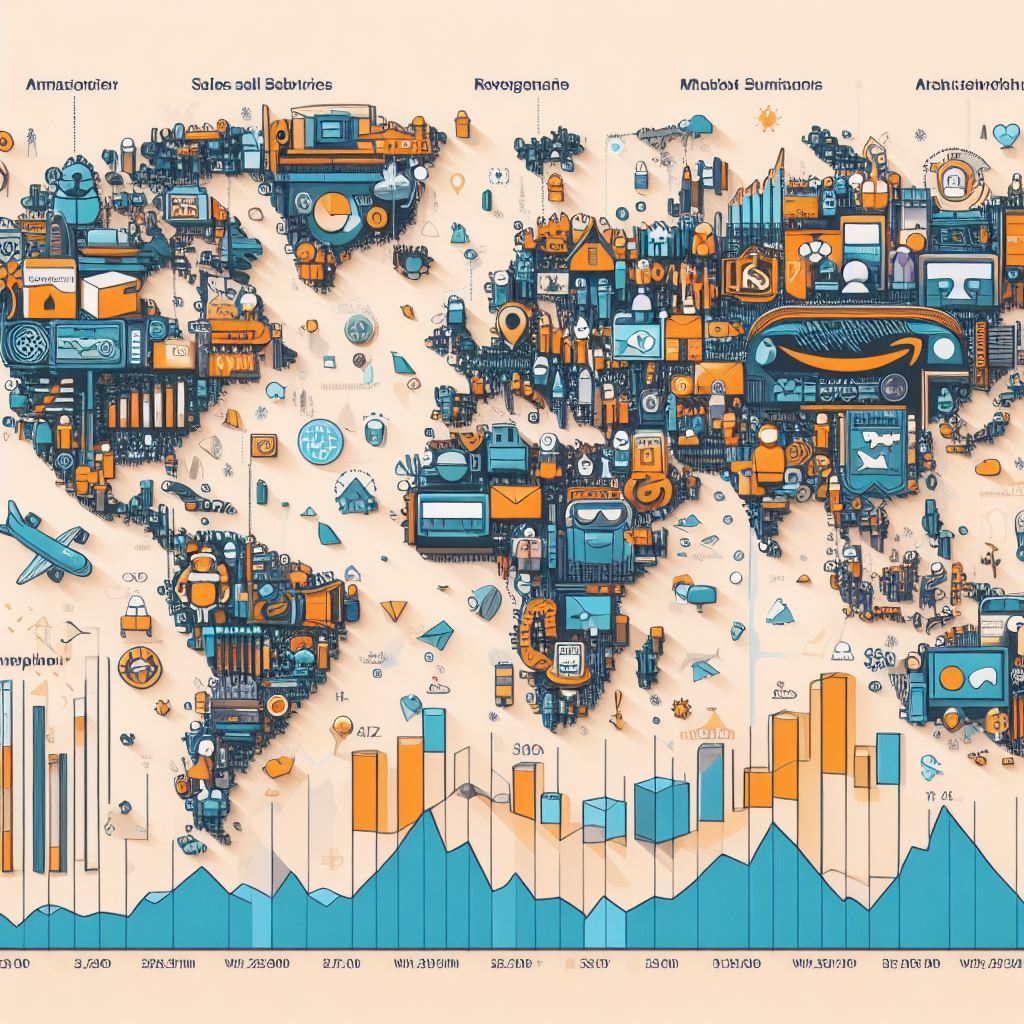Discover Which Country Uses Amazon the Most?And Other Random Facts About Amazon The Online Retail Giant
Welcome to the exploration of Amazon’s global impact and the significance of its vast customer base. In this article, we dive into the foundational understanding of Amazon’s influence on the world of e-commerce and its role in shaping the modern consumer landscape.
Thank you for reading this post, don't forget to subscribe!
List of Countries That Use Amazon The Most
1. United States: As the birthplace of Amazon, it comes as no surprise that the United States tops the list of countries that use Amazon the most. With a vast customer base and a wide range of products available, Amazon has become an integral part of American consumers’ lives.

2. United Kingdom: The United Kingdom is another country where Amazon has gained immense popularity. With its fast and reliable delivery services, extensive product selection, and competitive prices, Amazon has become the go-to online marketplace for UK shoppers.

3. Germany: Known for its efficiency and strong e-commerce market, Germany is a significant user of Amazon. German consumers appreciate the convenience and reliability of Amazon’s services, making it one of the most popular online shopping platforms in the country.
4. Japan: Amazon has made significant strides in Japan, becoming a preferred choice for online shopping. With its vast selection of products, including both local and international brands, Amazon has successfully captured the attention of Japanese consumers.
5. Canada: Canadian consumers have embraced Amazon as a convenient and reliable online shopping destination. With its Prime membership offering fast and free shipping, Amazon has become a go-to platform for Canadians looking for a wide range of products at competitive prices.

6. France: France is another country where Amazon has gained a strong foothold. Despite facing some resistance from local retailers, Amazon’s extensive product range, competitive prices, and efficient delivery services have made it a popular choice among French consumers.
7. Italy: Amazon has experienced significant growth in Italy, attracting a large number of consumers with its diverse product offerings and reliable services. Italian shoppers appreciate the convenience and ease of shopping on Amazon, making it one of the most used e-commerce platforms in the country.
8. Spain: Spain is another country where Amazon has seen considerable success. With its fast delivery services, competitive prices, and a wide range of products, Amazon has become a preferred choice for Spanish consumers looking for a convenient and reliable online shopping experience.
9. Australia: Since its launch in Australia in 2017, Amazon has quickly gained popularity among Australian consumers. With its extensive product range, competitive prices, and fast delivery services, Amazon has become a significant player in the Australian e-commerce market.

10. India: Amazon has made significant inroads in India, becoming one of the leading e-commerce platforms in the country. With its vast selection of products, competitive prices, and reliable delivery services, Amazon has become a go-to destination for Indian consumers looking for a seamless online shopping experience.
11. Brazil: Amazon’s presence in Brazil has been steadily growing, attracting a large number of consumers with its diverse product offerings and competitive prices. With its reliable delivery services and convenient shopping experience, Amazon has become increasingly popular among Brazilian shoppers.
12. Mexico: Mexico is another country where Amazon has gained traction. With its extensive product range, competitive prices, and reliable delivery services, Amazon has become a preferred choice for Mexican consumers looking for a convenient and trustworthy online shopping platform.

13. China: Although facing tough competition from local e-commerce giants, Amazon has managed to establish a presence in China. With its international product offerings and reliable services, Amazon has attracted a niche market of Chinese consumers looking for imported goods.
14. Netherlands: Amazon’s expansion into the Netherlands has been well-received by Dutch consumers. With its diverse product range, competitive prices, and efficient delivery services, Amazon has quickly become a popular choice for online shopping in the Netherlands.
15. Singapore: Amazon’s entry into the Singaporean market has been met with enthusiasm from local consumers. With its extensive product selection, competitive prices, and reliable delivery services, Amazon has become a preferred choice for Singaporeans looking for a seamless online shopping experience.
Please note that this list is not exhaustive and may vary based on market trends and consumer preferences.
List of Countries in Order of Amazon Market Share
1. United States
2. Germany
3. United Kingdom
4. Japan
5. France
6. Canada
7. Italy
8. Spain
9. Australia
10. India
11. Brazil
12. Mexico
13. Netherlands
14. Turkey
15. Sweden
16. Singapore
17. United Arab Emirates
18. Saudi Arabia
19. South Korea
20. Belgium
Understanding Amazon’s Global Impact
Amazon, the e-commerce behemoth founded by Jeff Bezos in 1994, has evolved into a global powerhouse that transcends geographical boundaries. Its transformative impact on how people shop and consume goods cannot be overstated. Here are some key aspects to consider:
Amazon’s Genesis
Amazon’s journey began as an online bookstore, but its vision quickly expanded beyond books to become the “everything store.” This visionary approach laid the foundation for its global domination.
The E-commerce Revolution
Amazon revolutionized the way people shop, moving them away from traditional brick-and-mortar stores to online platforms. Its user-friendly interface, vast product selection, and convenient delivery options made e-commerce accessible to the masses.
Disruption of Retail
The retail landscape witnessed a seismic shift as Amazon’s presence grew. Established retailers had to adapt or face obsolescence, while new opportunities emerged for businesses to thrive on Amazon’s platform.
Job Creation and Economic Impact
Amazon’s global footprint extends to numerous fulfillment centers, creating jobs and stimulating local economies. However, its rapid expansion has also prompted debates about labor practices and its influence on local businesses.
Technological Innovation
Beyond e-commerce, Amazon has ventured into cutting-edge technologies, including cloud computing (Amazon Web Services) and smart devices (Amazon Echo). These innovations have further solidified its position as a tech giant.
The Significance of Amazon’s User Base
Central to Amazon’s success is its ever-expanding user base. Let’s explore the importance of this user base in shaping Amazon’s strategies and its impact on global commerce:
Vast Customer Reach
Amazon’s user base spans the globe, providing access to an extensive and diverse customer demographic. This reach allows businesses to tap into a broad market.
Personalization and Data
Amazon’s sophisticated algorithms analyze user data to offer personalized recommendations and enhance the shopping experience. This data-driven approach has redefined marketing and customer engagement.
Prime Membership
Amazon Prime, a subscription service offering benefits like free shipping and exclusive content, has cultivated customer loyalty and encouraged recurring purchases.
Seller Opportunities
Amazon’s user base attracts third-party sellers seeking to reach a vast audience. The Amazon Marketplace provides a platform for businesses of all sizes to thrive.
As we progress through this article, we will explore Amazon’s global reach, its dominance in specific markets, and the trends shaping its future. Buckle up for a journey through the dynamic world of Amazon and its profound impact on the way we shop and live.
Chapter 2. The United States: Amazon’s Largest User Base
When we talk about Amazon’s global dominance, one country stands out as its undisputed stronghold—the United States. In this chapter, we’ll explore the significance of the U.S. market for Amazon, the proliferation of Amazon Prime memberships, household adoption of this service, and how Amazon has solidified its market dominance in the country.
2.1. The United States as the Leading Amazon Market
Market Size and Scope:
- The United States serves as Amazon’s largest market, contributing significantly to its global revenue.
- With a population of over 330 million people, the U.S. offers a massive customer base.
Consumer Behavior:
- American consumers have embraced online shopping, making e-commerce a fundamental part of their lives.
- The convenience of Amazon’s platform and quick delivery options have contributed to its popularity.
2.2. The Proliferation of Amazon Prime Memberships
Prime’s Attraction:
- Amazon Prime, the company’s subscription service, has played a pivotal role in cementing customer loyalty.
- Members enjoy benefits such as free two-day shipping, access to Prime Video, and exclusive deals.
Membership Growth:
- Amazon Prime has seen remarkable growth in the U.S., with millions of subscribers.
- Its expansion into additional services like Amazon Prime Music and Prime Pantry has added value to memberships.
2.3. Household Adoption of Amazon Prime
Household Penetration:
- Amazon Prime has become a household staple, with many U.S. families subscribing to the service.
- It offers a diverse range of benefits that cater to different age groups and preferences.
Streaming Services:
- Prime Video has become a significant player in the streaming industry, competing with giants like Netflix.
- Amazon’s original content and exclusive shows have garnered critical acclaim.
2.4. Amazon’s Market Dominance in the U.S.
Competitive Landscape:
- While there are other e-commerce players in the U.S., Amazon’s vast product selection and logistics network give it a competitive edge.
- The company continues to invest in innovations like drone delivery and cashier-less stores to maintain its lead.
Local Impact:
- Amazon’s presence extends beyond e-commerce, with fulfillment centers and data centers contributing to job creation.
- Its influence on local economies and small businesses has sparked debates about its impact.
As we move forward in this article, we’ll explore Amazon’s global reach, its prominence in various international markets, and the strategic factors that have contributed to its success on a global scale. Next, we’ll turn our attention to the broader international landscape and the key markets that have shaped Amazon’s global footprint.
Chapter 3. Amazon’s Global Reach
In this chapter, we’ll dive into the expansive international presence of Amazon, exploring key markets beyond the United States, examining how Amazon’s revenue is distributed across countries, and understanding the impact of emerging markets on the e-commerce giant.
3.1. Overview of Amazon’s International Presence
Global Footprint:
- Amazon’s reach extends far beyond its home country, the United States.
- The company operates in numerous countries across North America, Europe, Asia, and beyond.
Diverse Offerings:
- Amazon adapts its services and offerings to suit the specific needs and preferences of each international market.
- This includes tailoring product selection, delivery options, and payment methods.
3.2. Key Markets Beyond the United States
Diverse Global Markets:
- Some of Amazon’s key markets include the United Kingdom, Germany, Japan, India, and Brazil, among others.
- Each of these markets presents unique challenges and opportunities.
Local Competition:
- Amazon often competes with local e-commerce players in these markets.
- Understanding and navigating local competition is crucial for its success.
3.3. Amazon’s Revenue Distribution Across Countries
Revenue Sources:
- Amazon generates revenue through various channels, including e-commerce sales, subscription services (like Amazon Prime), and cloud computing (Amazon Web Services).
- The distribution of revenue varies from one country to another.
Regional Variations:
- Amazon’s revenue distribution can reveal insights into the economic strength and consumer behavior of different regions.
- Understanding these variations helps Amazon allocate resources effectively.
3.4. Emerging Markets and Their Impact
Growth Potential:
- Emerging markets in Asia, Latin America, and Africa offer significant growth opportunities for Amazon.
- Rising middle classes and increasing internet penetration drive demand.
Challenges and Rewards:
- Entering and expanding in emerging markets comes with challenges related to logistics, regulatory compliance, and cultural differences.
- Successfully navigating these challenges can result in substantial rewards.
As we delve deeper into Amazon’s global landscape, we’ll uncover the role of specific countries like Germany, the United Kingdom, and Japan in Amazon’s international success. We’ll also explore how Amazon adapts its strategies to suit regional differences and examine the opportunities and challenges it faces in emerging markets. Stay tuned to gain a comprehensive understanding of Amazon’s global reach and influence.
Chapter 4. Germany: A Strong Contender
Germany has emerged as a formidable player in Amazon’s global landscape. In this chapter, we’ll delve into the prominence of Germany, its role in Amazon’s international revenue, and the competitive markets it navigates in Europe.
4.1. Germany’s Prominence in Amazon’s Global Landscape
Strategic Location:
- Germany’s central location in Europe makes it a key hub for Amazon’s European operations.
- Its strong infrastructure and connectivity facilitate efficient distribution.
E-commerce Adoption:
- German consumers have embraced online shopping, contributing to the growth of Amazon’s presence.
- A tech-savvy population and high internet penetration have fueled this trend.
4.2. The Role of Germany in Amazon’s International Revenue
Significant Contribution:
- Germany consistently ranks among Amazon’s top international markets in terms of revenue.
- Its contribution to Amazon’s global earnings is substantial.
Amazon.de:
- Amazon’s dedicated German website, Amazon.de, serves as a primary platform for reaching German customers.
- The site offers a wide range of products, competitive pricing, and reliable delivery options.
4.3. Competitive Markets in Europe
European E-commerce Landscape:
- Europe is a highly competitive e-commerce landscape, with both local and international players vying for market share.
- Amazon faces competition from companies like Zalando, Otto, and Alibaba’s AliExpress.
Localized Approach:
- Amazon adapts its strategy to cater to European consumers, recognizing the diversity of cultures and languages.
- It offers services like Amazon Prime and Amazon Fresh to enhance the customer experience.
Germany’s role in Amazon’s global strategy cannot be understated. Its strategic location, strong e-commerce adoption, and significant contribution to Amazon’s revenue highlight the importance of the German market. In the next chapter, we will explore another crucial market: the United Kingdom, and its unique influence on Amazon’s growth in Europe.
Chapter 5. United Kingdom and Japan: Amazon’s European and Asian Markets
As we continue our exploration of Amazon’s global presence, we shift our focus to two distinct yet strategically important markets: the United Kingdom and Japan. These countries play pivotal roles in Amazon’s expansion and offer unique opportunities and challenges.
5.1. The UK and Its Influence on Amazon’s Growth
Market Size and Sophistication:
- The United Kingdom ranks among Amazon’s top markets outside the United States.
- Its large population and robust e-commerce landscape make it a significant contributor to Amazon’s global revenue.
Innovation Hub:
- The UK serves as an innovation hub for Amazon, housing Amazon Web Services (AWS) data centers and research facilities.
- It’s a critical center for technology and digital services development.
Challenges in the UK:
- While the UK market is lucrative, it’s also highly competitive, with local giants like Tesco and Asda.
- Amazon continually innovates to maintain its competitive edge.
5.2. Japan’s Unique Position in Amazon’s Portfolio
E-commerce Culture:
- Japan has a rich e-commerce culture with strong consumer trust in online shopping.
- Amazon Japan, known as Amazon.co.jp, benefits from this culture.
Fulfillment Centers and Logistics:
- Amazon has invested significantly in fulfillment centers and logistics infrastructure in Japan.
- Efficient delivery and a vast product catalog contribute to Amazon’s success in the country.
Localization Efforts:
- Amazon adapts its services to cater to Japanese consumers, offering Japanese-language support and localized content.
5.3. Regional Differences and Strategies
Balancing Act:
- Amazon’s success in the UK and Japan showcases its ability to balance global strategies with local adaptation.
- Tailoring services to regional preferences is a key part of Amazon’s approach.
Market-Specific Challenges:
- Each market comes with its unique challenges, from regulatory compliance to consumer preferences.
- Amazon’s strategies in these markets reflect its adaptability.
In the next chapter, we’ll turn our attention to the evolving landscape of emerging markets and the opportunities they present for Amazon’s continued growth and expansion.
Chapter 6. Emerging Markets and Opportunities
In this chapter, we delve into the exciting world of emerging markets and the incredible opportunities they present for Amazon’s continued global expansion. These markets are often characterized by rapid economic growth, a burgeoning middle class, and a growing appetite for e-commerce.
6.1. Growth Potential in Developing Economies
Untapped Potential:
- Emerging markets encompass a wide range of countries, from Southeast Asia to South America and Africa.
- Many of these markets have large populations eager to embrace online shopping.
Economic Growth:
- Amazon can benefit from the rising disposable incomes in emerging markets.
- As people’s purchasing power increases, their online spending follows suit.
E-commerce Adoption:
- E-commerce adoption rates in these markets are on the rise, driven by improved internet access and mobile device penetration.
- Amazon’s global reach positions it to tap into these burgeoning markets effectively.
6.2. Amazon’s Expansion into New Territories
Strategic Expansion:
- Amazon has been strategically expanding into emerging markets, customizing its approach to suit local preferences.
- Investments in logistics and fulfillment centers facilitate speedy deliveries.
Challenges and Competition:
- These markets come with unique challenges, including logistical hurdles and regulatory complexities.
- Local e-commerce players often provide stiff competition, requiring Amazon to adapt and innovate.
6.3. Challenges and Rewards in Untapped Markets
Diverse Consumer Preferences:
- Understanding the diverse preferences of consumers in emerging markets is crucial.
- Amazon tailors its product offerings to cater to local tastes and preferences.
Last-Mile Delivery Solutions:
- Last-mile delivery can be a significant challenge in emerging markets with less developed infrastructure.
- Amazon’s innovative solutions, such as lockers and delivery points, address these challenges.
Building Trust:
- Building trust among consumers is paramount, and Amazon invests in customer service and reliability.
- Word-of-mouth and positive experiences play a pivotal role in gaining market share.
As we examine Amazon’s journey into these promising markets, it becomes evident that the company’s adaptability and innovation are key drivers of its success. In the next chapter, we shift our focus to Amazon’s role in the broader e-commerce landscape and its competition with rival platforms.
Chapter 7. Amazon’s Dominance in Online Shopping
In this chapter, we explore Amazon’s pivotal role in the ever-evolving landscape of online shopping. Amazon’sinfluence extends far beyond just being an e-commerce platform; it has become synonymous with online retail, reshaping the way consumers shop and businesses operate.
7.1. Amazon’s Role in the E-commerce Landscape
E-commerce Evolution:
- Amazon’s journey began with books but rapidly expanded into diverse product categories.
- It pioneered online marketplaces, setting new standards for online shopping.
Marketplace Powerhouse:
- Amazon’s marketplace allows third-party sellers to reach a global audience.
- This ecosystem drives competition and choice for consumers.
Logistics and Fulfillment:
- Amazon invested heavily in logistics and fulfillment centers for speedy and reliable deliveries.
- Programs like Fulfillment by Amazon (FBA) simplify the selling process for merchants.
7.2. Competition and Rival Platforms
Competitive Landscape:
- Amazon faces competition from both traditional retailers and tech giants entering e-commerce.
- Companies like Walmart and Alibaba are vying for a piece of the e-commerce pie.
Rival Platforms:
- Marketplaces like eBay and emerging platforms challenge Amazon’s dominance.
- These platforms offer unique selling propositions and experiences.
E-commerce Ecosystems:
- The battle extends beyond marketplaces; ecosystems like Shopify empower smaller businesses.
- Amazon Web Services (AWS) provides cloud infrastructure to numerous online businesses.
7.3. Consumer Trust and Loyalty
Consumer-Centric Approach:
- Amazon’s focus on customer experience is a cornerstone of its success.
- Customer reviews, easy returns, and fast shipping build trust and loyalty.
Prime and Subscription Models:
- Amazon Prime offers a premium membership with benefits like fast shipping and streaming.
- Subscription services like Prime have led to higher customer retention.
Data and Personalization:
- Amazon leverages data to offer personalized recommendations.
- AI and machine learning enhance the shopping experience.
As we delve into Amazon’s dominance in online shopping, it becomes evident that its adaptability, innovation, and customer-centric approach are driving forces behind its success. In the next chapter, we shift our attention to Amazon Prime, a key driver of the company’s growth and user loyalty.
Chapter 8. Amazon Prime: A Key Driver
Amazon Prime, a subscription program launched by Amazon in 2005, has evolved into a cornerstone of the company’s success. In this chapter, we delve into the power of Amazon Prime, its myriad benefits, and the significant influence it wields over user behavior and Amazon’s overall strategy.
8.1. The Power of Amazon Prime
Prime’s Genesis:
- Amazon Prime started as a program offering fast and free shipping to members.
- It has since expanded to encompass a wide range of services, transforming e-commerce.
Membership Growth:
- Prime boasts millions of members globally, contributing significantly to Amazon’s revenue.
- Memberships surged as Amazon introduced additional benefits.
Amazon’s Competitive Edge:
- Prime differentiates Amazon from competitors, fostering customer loyalty.
- The convenience of two-day or even same-day shipping sets high expectations.
8.2. Prime Membership Benefits
Fast and Free Shipping:
- Prime members enjoy expedited shipping on a vast selection of products.
- Speedy deliveries keep customers satisfied and encourage more frequent shopping.
Amazon Prime Video:
- Prime includes access to a vast library of movies, TV shows, and exclusive content.
- Original programming, like “The Marvelous Mrs. Maisel,” attracts subscribers.
Amazon Prime Music:
- Subscribers can stream music, create playlists, and enjoy a diverse catalog.
- Music streaming is a competitive arena, and Amazon Prime Music holds its ground.
Prime Reading and Twitch Prime:
- Prime offers access to e-books, magazines, and gaming perks through Twitch.
- These benefits enhance the overall value of Prime membership.
8.3. Prime’s Influence on User Behavior
Increased Spending:
- Prime members tend to spend more on Amazon than non-members.
- The allure of free shipping and exclusive deals drives higher order frequency.
Enhanced Loyalty:
- Prime fosters customer loyalty, reducing the likelihood of members shopping elsewhere.
- The sense of belonging to an exclusiveclub strengthens Amazon’s customer base.
Content Consumption:
- Amazon Prime Video and Music encourage users to stay within the Amazon ecosystem.
- Original content keeps users engaged, contributing to overall platform stickiness.
As we examine the impact of Amazon Prime, it becomes clear that this subscription program is more than just a perk for shoppers—it’s a strategic cornerstone that drives growth, customer loyalty, and Amazon’s ongoing evolution. In the next chapter, we explore Amazon’s future trends and projections in the ever-dynamic world of e-commerce.
Chapter 9. Amazon’s Future: Trends and Projections
As we look toward the future of Amazon, it becomes increasingly evident that the e-commerce giant is on an ever-evolving trajectory. In this chapter, we explore the various trends and projections that will shape Amazon’s path in the coming years.
9.1. Amazon’s Ongoing Evolution
Diversification of Services:
- Amazon’s journey extends beyond e-commerce; it has ventured into diverse sectors.
- Cloud computing, artificial intelligence (AI), and entertainment are pivotal domains.
Physical Retail Expansion:
- Amazon’s acquisition of Whole Foods and Amazon Go stores signifies a push into brick-and-mortar retail.
- Hybrid shopping experiences could redefine the future of physical stores.
Global Expansion:
- Amazon continues to penetrate new markets, with a focus on emerging economies.
- Strategies for conquering diverse cultural landscapes are paramount.
9.2. Innovations in E-commerce
Voice Commerce (V-commerce):
- Voice-activated devices like Alexa are changing the way consumers shop.
- Convenience and personalized experiences are key drivers of V-commerce.
Augmented Reality (AR) and Virtual Reality (VR):
- AR and VR technologies enhance product visualization and immersive shopping.
- Amazon’s investment in AR/VR innovations promises an engaging shopping future.
Sustainability Initiatives:
- Environmental consciousness is integral to Amazon’s future.
- A commitment to sustainability influences operations and customer expectations.
9.3. Projected Growth and Challenges Ahead
Marketplace Growth:
- Amazon’s marketplace will likely continue expanding, attracting third-party sellers.
- Enhanced product discovery and seller support will drive growth.
Competition and Regulatory Challenges:
- Amazon faces scrutiny over its market dominance and antitrust concerns.
- Regulatory changes may impact the company’s operating practices.
Logistics and Last-Mile Delivery:
- Efficient logistics and last-mile delivery remain vital to Amazon’s success.
- Investments in technology and infrastructure are ongoing.
In conclusion, Amazon’s future holds promises of further diversification, innovation, and global expansion. However, it also faces formidable challenges in navigating regulatory landscapes and maintaining its logistical prowess. Businesses and consumers alike will closely watch Amazon’s journey in the years to come, as it continues to shape the landscape of e-commerce and beyond.
Chapter 10. Conclusion
In this final chapter, we bring together the key insights and implications of Amazon’s global impact, its user base, market dominance, and future prospects. Let’s delve into the concluding remarks and the ever-evolving Amazon ecosystem.
10.1. Recap of Amazon’s Global Impact
E-commerce Revolution:
- Amazon pioneered the e-commerce revolution, changing how consumers shop.
- Its marketplace and fulfillment networks transformed retail dynamics.
Global Presence:
- Amazon’s international expansion made it a household name worldwide.
- The company’s digital services, like AWS, have reshaped industries.
Market Dominance:
- Amazon’s dominance in online shopping is unparalleled.
- Its influence extends to cloud computing, entertainment, and more.
10.2. Key Takeaways and Implications for Businesses
E-commerce Imperative:
- Businesses must adapt to the digital ageand embrace e-commerce.
- Amazon’s marketplace offers opportunities for third-party sellers.
Customer-Centric Approach:
- Amazon’s success is rooted in customer-centricity.
- Businesses can learn from its focus on convenience and personalization.
Logistics and Innovation:
- Efficient logistics and continuous innovation are vital.
- Embracing emerging technologies can drive growth and competitiveness.
10.3. The Ever-Evolving Amazon Ecosystem
Diverse Ventures:
- Amazon’s ecosystem spans e-commerce, cloud computing, entertainment, and more.
- The company’s acquisitions and ventures diversify its portfolio.
Future Prospects:
- Amazon’s future holds innovations like voice commerce, AR/VR, and sustainability.
- Regulatory challenges and competition will shape its journey.
Ongoing Evolution:
- Amazon’s story is one of continuous evolution.
- Its ability to adapt and innovate remains a central theme.
As we conclude this comprehensive exploration of Amazon, it’s evident that the company’s impact on the global landscape is profound. From its humble beginnings as an online bookstore to its position as a tech giant, Amazon’s journey has been nothing short of transformative. Businesses and consumers alike will continue to watch Amazon’s evolution, as it navigates challenges, explores new frontiers, and redefines the world of e-commerce.
Thank you for joining us on this journey through Amazon’s world. We hope this article has provided valuable insights into one of the most influential companies of our time.
These are excellent questions that touch upon key aspects of Amazon’s global presence and its impact on e-commerce and business. Below, I provide concise answers to each of your questions:
FAQ Which Country Uses Amazon the Most?
Which country has the largest Amazon user base?
The United States has the largest Amazon user base. It’s where Amazon was founded and has a significant presence, with millions of active users.
How many Amazon Prime members are there in the United States?
there were over 200 million Amazon Prime members worldwide, with a significant portion of them in the United States. However, for the most up-to-date numbers, I recommend checking Amazon’s official reports.
What is the significance of Amazon Prime for Amazon’s success?
Amazon Prime is highly significant for Amazon’s success. It fosters customer loyalty, encourages frequent shopping, and provides access to a range of services like Prime Video and Prime Music. It’s a key driver of Amazon’s revenue and profitability.
How does Amazon’s user base vary across different countries?
Amazon’s user base varies from country to country. In the United States, it’s extensive, while in other countries, it may be smaller. Cultural, economic, and logistical factors influence the user base in each region.
What challenges does Amazon face in expanding to new markets?
Expanding to new markets poses challenges such as cultural differences, regulatory hurdles, competition from local e-commerce platforms, and adapting to varying consumer preferences. Logistics and infrastructure can also be challenging in some regions.
What are the key factors contributing to Amazon’s dominance in online shopping?
Amazon’s dominance in online shopping is driven by factors like its vast product selection, competitive pricing, efficient logistics and delivery, a user-friendly shopping experience, and the trust it has built with customers over the years.
How does Amazon compare to its competitors in the e-commerce industry?
Amazon is a leader in the e-commerce industry, with a strong global presence. It competes with companies like Alibaba, Walmart, and eBay. Amazon’s focus on customer-centricity and innovation sets it apart.
What are the future trends and projections for Amazon’s global presence?
The future for Amazon includes potential expansion into new markets, continued growth in e-commerce, advancements in technology like voice commerce and AI, and increased sustainability efforts. Amazon’s global presence is expected to continue evolving.
What opportunities and challenges await businesses in the Amazon ecosystem?
Businesses can find opportunities in selling on Amazon’s platform, utilizing AWS for cloud services, and leveraging Amazon’s logistics network. However, they also face challenges such as competition, fulfillment complexities, and adapting.
For the most current and detailed information, I recommend referring to Amazon’s official reports and recent news sources.

